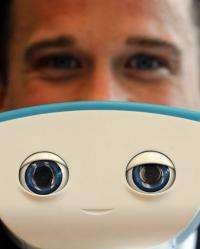Robot takes on battle of the bulge

Imagine something between a computer game and a pet that helps makes you slim. One inventor did just that and came up with Autom -- a robot that will look dieters in the eye and tell them what they need to hear.
Users can have daily conversations with the 38-centimetre-tall (15-inch) robot, which will crunch calories and provide feedback and encouragement on their weight-loss progress.
For those who hate manuals -- there isn't one. Switch Autom on and it's ready to go.
Its blue eyes open and its head swivels as a computer inside its head allows it to search for a human face in front of it and maintain eye contact.
"Hello, I'm Autom! Press one of the buttons below to talk to me," it says in a robotic female voice with an American accent. "I'm ready to get started. Let's keep working together."
Users tap their details onto the robot's screen in response to its spoken questions about weight, diet, exercise regime and goals and over time it builds up a knowledge of the dieter's strengths and weaknesses to tailor its questions and advice accordingly.
The information is also processed to provide graphs on their progress and habits over time.
The brainchild of Cory Kidd, a graduate of the Massachusetts Institute of Technology with a doctorate in human-robot interaction, Autom hits the US market later this year, retailing for about 500 dollars.
The 80-billion-dollar US weight loss market has already been targeted by Nintendo with its Wii Fit and My Weight Loss Coach games but Kidd is banking on Autom offering dieters a more personalised way of using technology to slim down.
It is a so-called sociable robot, a new generation of robots that adapt their behaviour in order to interact with humans.
Autom looks fairly simplistic, with a head and neck attached to a rectangular box-shaped body on two stumpy legs. Its face has no nose and only the hint of a mouth.
But the cutting-edge field of human-robot interaction combines insights from the social sciences as well as technology and medicine
"It draws heavily on human psychology -- so understanding how we as people interact with one another," Kidd told AFP. "It relies on cues that people use in everyday communication."
For example, Autom looks down at the screen on its torso briefly when asking for the user to put in information, in the way people naturally glance at something they are mentioning.
Next year a more developed model will be released that uses voice recognition technology so the dieter can speak to the robot as well as communicate via the touch screen.
Lona Sandon, assistant professor of clinical nutrition at the University of Texas, had not seen Autom in action and said she was reserving judgement about how successful the product would be.
"For some people it could be a good tool. You need constant feedback so I can see how it would be beneficial but there is a novelty factor and some will just get bored of it when that wears off like they do with everything else," said Sandon, who is also a spokeswoman for the American Dietetic Association.
But according to Kidd, Autom's human qualities, if primitive, were an important factor in keeping 15 dieters motivated during a trial in the Boston area.
Another 15 slimmers were given a computer with a touch screen running identical software to Autom's and 15 had a paper log. Each had to stick to a certain eating and exercise regime.
The average time someone used the robot -- almost 51 days -- was nearly twice as long as with paper -- almost 27 days -- and 40 percent longer than with the computer.
"Even if you have an animated character that looks exactly like Autom on the computer screen, you cannot have the same interaction as you can with an actual robot," Kidd says.
"The robot was a rougher version of this one but was extremely effective at engaging someone over a period of time and helping them to stick with whatever diet programme they were on."
Kidd says the fact that people were able to humanise Autom made the information it gave them seem more credible. Maya, Casper and Robbie were among the names users gave their robots. Some even dressed them in hats and scarves.
"When people develop a kind of bond with something, it's almost like a pet," says Kidd.
As the costs come down for certain technologies, Kidd says users will have more opportunity to personalise the robot -- the colour, the clothes, the personality. Even the voice could be customised to sound like that of your favourite celebrity.
"You'll see a lot of changes in the next few years. In 30 years this is going to look very primitive," he said.
"Technology has really advanced in the last decade to allow us to finally create something like this. A lot of what goes into this would 10 years ago have not been possible. Five years ago it would not have been feasible and two years ago it would not have been affordable."
Kidd's company Intuitive Automata is based in Hong Kong and Autom also speaks Chinese -- both Cantonese and Mandarin.
Initially, though, the company will use an English-language version to target the United States, where the government estimates two-thirds of the population is overweight or obese, followed by Europe.
Kidd is confident the model can be adapted to different languages and cultures as well as other health issues -- chronic disease management, diabetes, even drug and alcohol abuse.
The UN Economic Commission and the International Federation of Robotics forecast a market for personal and service robots worth about 52 billion US dollars by 2025.
(c) 2010 AFP




















